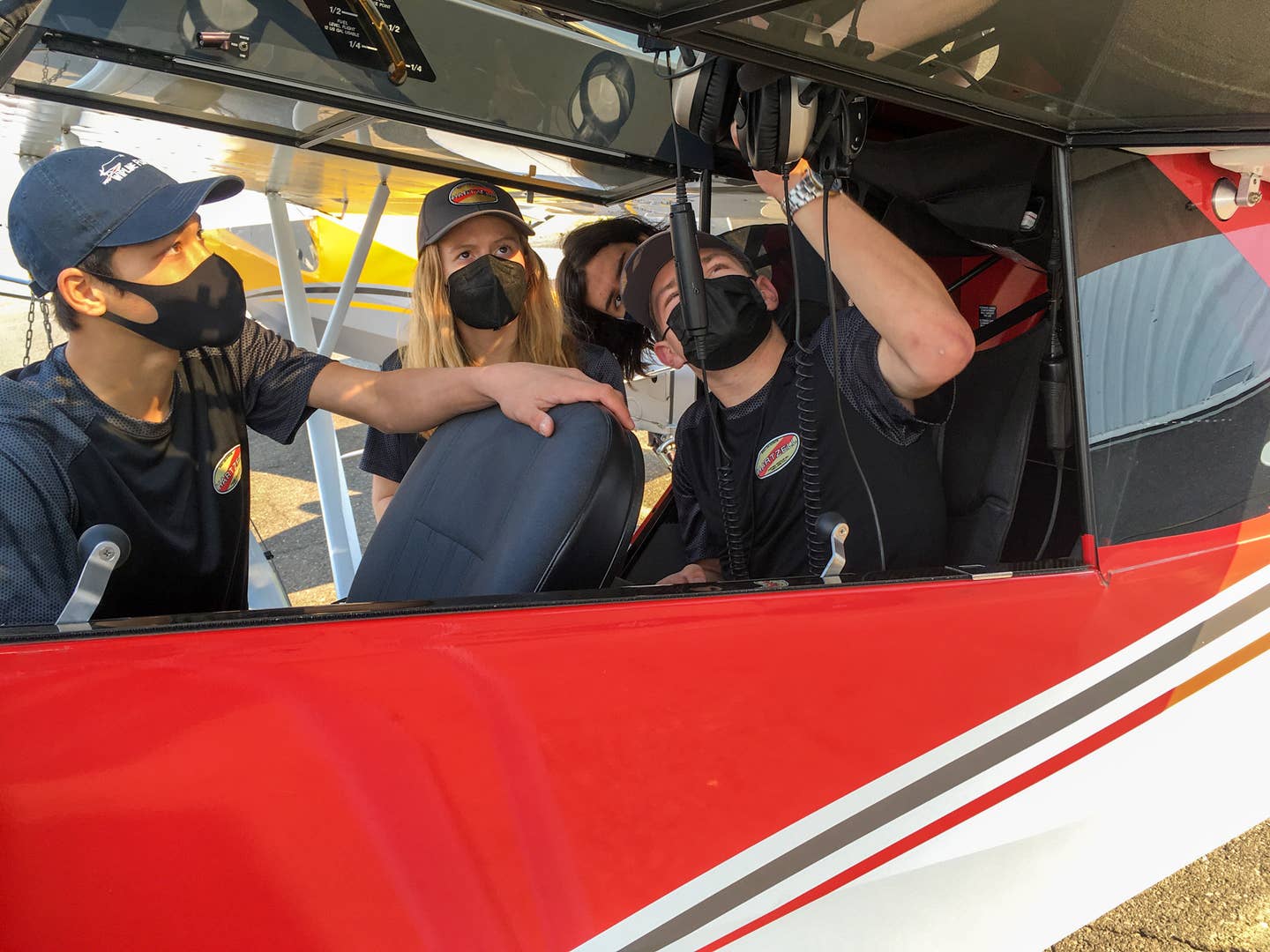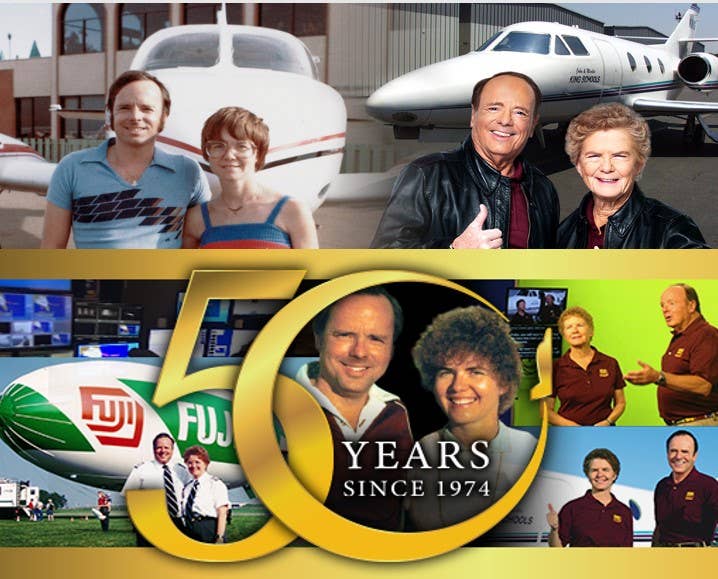
From left to right, Jason Poon (11), Lyra Young (12), Atticus Bhat and Garett Griner in a Carbon Cub FX3 installing headset hooks that Raisbeck students designed and 3D printed. Courtesy: Lyra Young
There are some basic challenges when offering an aviation class to high school students, such as:
- Private pilot ground school at a public high school;
- Finding someone who is qualified to teach the class, because in addition to a state teaching certificate, the person needs FAA certification;
- Keeping the class from getting lost amidst college-prep courses, music, sports, social studies, and more.
"The secret to keeping the aviation program alive is to build the high school culture around aviation," said Reba Gilman, a 40-year educator and the driving force behind the creation of Raisbeck Aviation High School (RAHS) in Tukwila, Washington. The school was established in the early 2000s after Gilman noted the popularity of technical aviation courses at the Puget Sound Skills Center (PSSC).
According to Gilman, she was impressed by the interest and passion the teens at the PSSC had for aviation, and realized the benefit of creating a school that would nurture that.
"We had to develop a school with a culture that was unique," Gilman said. "We had to have a school with a culture and a community that revolves around STEM (science, technology, engineering and math), and for us, that meant aviation and aerospace."
A grant from the Gates Foundation helped launch the school in 2004. That first year there were 50 students and two teachers. Today, the school has 400 students in grades 9 through 12. Gilman was the first principal of the fledgling high school, serving in that position until 2014.
The Need for Space
RAHS continued to add students and teachers. In 2007, the program was temporarily relocated to a former elementary school campus within the school district. By this time, the school served teens in secondary grades. It was somewhat comical to watch the adult-sized high school students attempting to use water fountains designed for grades K through 6, Gilman said.
In 2011, work began on a $44 million facility built on land belonging to the Museum of Flight. Approximately 32 percent of the money came from the school district, 23 percent by the Port of Seattle, 9 percent from the State of Washington, 1 percent from the federal government—and 35 percent came from private donors, including a multimillion-dollar donation from James and Sherry Raisbeck for whom the school is named.
RAHS officially opened on September 9, 2013.
STEM Project-based Learning
The emphasis of STEM is to engage students and encourage them to develop critical thinking, problem solving, creativity, and collaborative skills that can be applied outside academic confines.
"The students do project-based learning; they have hands-on experiences in technology and engineering programs, digital electronics, aerospace engineering, computer science, and advanced senior flight design, which is a project-based learning class where they learn as a class to develop ideas and designs for industry partners," said Therese Tipton, the current RAHS principal.
Engineering, Tipton said, is the most popular application.
"The school graduates approximately 100 students a year, and the majority of those are students who chose an engineering pathway, be it mechanical, computer or electrical engineering," she said. "We also offer non-STEM classes, such as our entrepreneurial pathway, because we recognize that we are not just training engineers and pilots.
“We want students who will be able to manage businesses someday—they may be managing Boeing or Alaska airlines.”
Community Involvement
Members of the aerospace industry are brought in to help both the students and teachers with projects. For example, there is a challenge presented to the sophomore class each year sponsored by the Port of Seattle, which oversees Sea-Tac International Airport (KSEA).
“"The secret to keeping the aviation program alive is to build the high school culture around aviation." ”
Reba Gilman, former principal, Raisbeck Aviation High School
"Deicing of airplanes was one that I vividly remember from a few years ago," Gilman said. "Students work in teams to design solutions to the current situations, then the port brings in port commissioners and other industry experts to listen to student presentations, ask questions, and rate their presentations according to a pre-designed rubric. This is the high stakes of learning—students defending their learning to those who are engaged in the work every day.”
The industry partners also mentor both students and teachers, Tipton said, noting that the student-mentor relationships often extend into college, and the teachers are free to reach out to industry professionals for curriculum guidance.
Getting In
Prior to 2016, “wannabe” students at RAHS had to follow a rigorous application process. There were interviews, and references were required, as the school accepts students from the greater Puget Sound area. Having such a wide draw created challenges when it came to admission, Tipton said, and the school established a lottery for prospective students.
There really isn't a way to prepare a student for a program like RAHS, said Tipton, beyond being sure that the student has a passion for learning. "We want any student who has a desire to attend to have an equal opportunity to be selected."
Meanwhile, in New York
On the other side of the country, Long Island, New York, to be precise, Aviation Career and Technical Education High School (also known as Aviation High School) has the distinction of being the oldest aviation high school in the U.S. Established in the 1920s, well before the concept of STEM was developed, the school focuses on technical training for students pursuing airframe and powerplant certification.
The education is very hands-on, noted Steven R. Jackson, the school’s principal, because the students are training for careers. A typical day finds four of them around an aircraft engine they are turning wrenches on. COVID hit them hard, Jackson said, because you have to be in close proximity to the engine to learn—and that's impossible over Zoom.
"We are a public high school in the state of New York. When the governor shut down the schools we shut down," Jackson said. "We shut down in March of 2020 and again in November, and now the kids are just getting back to it. It has been a challenge—we have juniors who left in March and sophomores who didn't get to finish the year, and a new class of freshmen."
The students and teachers are making up for lost time by holding classes after traditional school hours and on Saturdays. The students are required to wear protective equipment such as face masks and face shields, because social distancing is often not possible when you are in a crew of four working on an aircraft engine.
In addition to learning the core subjects required for traditional high school completion, the students at New York Aviation High School learn technical skills such as engine maintenance, metal working, and electronics geared toward preparing them for careers as aviation technicians.
"The teachers are certified through both the state of New York and the FAA," Jackson said, adding that many of the teachers are graduates of the program who have experience working at airlines such as Delta and JetBlue, or for other aviation companies. “They come back to the school because of the supportive family atmosphere.”
Five-Year, Dual-Certificate Program
The school is an FAA-certificated Part 147 program, which means that in addition to meeting the academic requirements for high school, math, English, social studies, physical education, etc., the students need to log 1,900 hours of instruction time to earn both their airframe and powerplant certificates.
"The school is a five-year program," Johnson said, “because you cannot do 1,900 hours of instruction on top of high school requirements in four years. You could do high school and earn the airframe or the powerplant certification in four years but not both, which is why most of our students come back for the fifth year. Those 1,900 hours are made up of lessons and instruction and demonstration and hands-on technical work in one of our 36 shops. They work on reciprocating engines, they work with sheet metal, with lubrication system, and advanced powerplant."
The more traditional aspects of high school are represented as well. According to Jackson, the students enjoy college-prep classes and a rich multicultural experience with lots of clubs and sports ranging from Junior ROTC to music and soccer.
The Student Body
The students are drawn from the five boroughs of New York. The school receives 5,000 applications a year but there are just 500 slots for students per class. Enrollment is limited to 2,000 students total, Jackson said, because instructional materials such as the engines and design boards, and the space to hold them, are limited.
"By their senior year they are working in aircraft in a hangar, they've been working on mockups throughout the years and working in crews."
Steven R. Jackson, principal, Aviation Career and Technical Education High School
According to Jackson, the students treat their aviation education like their job, because in order to be certificated, they must pass both a practical and oral exam—something they start training for their freshman year.
"By their senior year they are working in aircraft in a hangar, they've been working on mockups throughout the years and working in crews. For example, there are crews of four for engine removal and installation, and they have a crew chief and foreman," he said.
The school has partnerships with several aviation companies ranging from airlines, such as Endeavor, Delta, and JetBlue, to aviation component manufacturers. Many of the students pursue internships with these companies and go to work for them after graduation.
"It has been very challenging but the kids are motivated and doing well. It is wonderful to see the kids back here and to be happy to be here. Things are not back to normal yet, [but] it's nice to see we are on that path," Jackson said.

Subscribe to Our Newsletter
Get the latest FLYING stories delivered directly to your inbox






